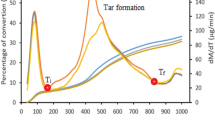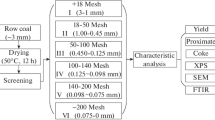Abstract
Coal is one of the main sources of energy in many parts of the world and has one of the largest reserves amongst all the nonrenewable energy sources. The effect of different size fractions of coal was analyzed by taking into account three types of coal namely, Australian Hard, prime coking coal (PCC) and medium coking coal (MCC). Various tests were helped in understanding the effect of different size fractions on coal properties. The bulk density of the master sample of all the three coals was found to be the average of the three size fractions i.e. +6 mm, +3.2 mm and –3.2 mm, respectively. The bulk density of all the three size fraction of coal decreased with decrease in size fractions. Also, a decrease in void spaces between the coal samples with decrease in size fraction was observed. Proximate analysis, crucible swelling number (CSN) and low temperature Gray King (LTGK) tests showed the values of the master sample to be an average of the three size fractions. There was a significant increase in volatile matter with decrease in size fraction. Generally, coal ash tends to retained in higher size fraction in coal.
Similar content being viewed by others
Avoid common mistakes on your manuscript.
INTRODUCTION
Coke quality in terms of cold and hot strength is most important parameters for smooth operation of blast furnace. Coke is the most important raw material fed into the blast furnace in terms of its effect on blast furnace operation and hot metal quality. Coke acts as a reducing agent and it need to be able to support a smooth descent of the blast furnace burden with as little degradation as possible while providing the lowest amount of impurities, highest thermal energy, highest metal reduction, and optimum permeability for the flow of gaseous and molten products [1, 2]. The bulk density of crushed coal charge is important for BF coke quality and coke oven productivity. It mainly depends on percentage of ash, moisture and granulometry. Higher content of +6 mm fraction in coal charge affects coke quality as this fraction is comparatively rich in total inert content and lower in rank. This fraction generates weak sports in coke matrix and is one of the reasons for inferior coke quality [3, 4].
In modem metallurgical industry, coke is still the primary raw material, but the coke quality required is now much higher than before. It is well known that the quality of coke depends to a large extent on the bulk density of coal charge that can be obtained in the coke oven. For example, it has been reported [5–7] that the mass of a charge loaded into an oven in a loose or non-uniform state, sometime occupies only 50–65% of the oven volume. The most progressive modem methods of increasing bulk density are compaction of the charge by tamping, partial briquetting, preheating, etc. However, adoption of these methods in practice requires a high capital investment. One of the methods not involving significant costs is to improve the non-uniform size distribution of the coal charge in the oven, that is minimizing the size segregation of the coal powder.
A coal is characterized by various, physical, chemical and petrographic properties. Proximate analysis is used to determine moisture, ash, volatile matter and fixed carbon. Cokeability of coal is yet another crucial parameter of coal during its reduction in furnace (generally, electric furnace), is usually determined by the crucible swelling number (CSN). Hence, is the simplest test to determine whether a coal is suitable for production of coke. High ash content is undesirable for the operation of thermal power stations as inert increases transport and waste disposal costs, and also means that the heat exchangers have to be cleaned more frequently [8–10].
The coking behavior of coal is an important facet in utilization of coal in metallurgy and in other industries. The carbonization behavior of coal mainly depends on coking properties, fluidity, coal rank, petrographic composition, ultimate composition and rheology of coal. Coal properties for coke making process not only affects the battery operation and coke quality but also affect the techno economy of the entire steel plants, as more than 50% of raw material cost is contributed by coal. Therefore, a cost effective and judicious utilization of coal is very much essential for the plant. In this study, Australian (Hard) coking coal, prime coking coal (PCC) and medium coking coal (MCC) was selected for understanding the effect of different size fractions on coking properties/quality.
EXPERIMENTAL
The effect of different size fractions of coal was analyzed by taking into account three types of coal namely, Australian Hard, PCC and MCC. The bulk density of the master sample of all the three coals was found to be the average of the three size fractions i.e. +6 mm, +3.2 mm and –3.2 mm, respectively. Each individual coking coal was emptied from their respective bags/containers. Representative master-sample of each coal was drawn after screening and crushing the +25 mm fraction to –25 mm, homogenization and air-drying, wherever necessary. Subsequent to homogenization followed by coning and quartering, the respective coal samples were prepared for the laboratory characterization tests. Each coal sample was screened to different size fractions followed by coning and quartering for sampling. Different tests like granulometry, proximate analysis, Crucible Swelling Number (CSN), low temperature Gray King (LTGK) tests, bulk density, Giesler fluidity and petrography were carried out in this study to analyze the effect on coal properties. A flow sheet for the detailed analysis of the testing process of the coal sample has been illustrated in Fig. 1.
RESULTS AND DISCUSSION
The analysis report of Australian hard coking coal at different size fractions is given in Table 1. From the table, it is clear that coal ash was varied from 8.4 to 11.2% and increased with increase in size fractions. Generally, coal ash tends to retained in higher size fraction in coal. Volatile matter was varied from 19.7 to 21.7% and decreased with increase in size fractions. CSN values was varied from 5.0 to 8.0 and also decreased with increase in size fractions. The same trend has been observed for LTGK for Australian hard coal. It is inferred that LTGK value for PCC and MCC coals did not change whatsoever. The change in the value was noted in the case of Australian Hard coal. There are no clear trends obtained for plastic range and MMR with size fractions. In case of maximum fluidity, maximum fluidity also shown improvement with decease size of coal particle except (–1 + 0.5 mm). This fraction sample (–1 + 0.5 mm) shown initial softening temperature of 421°C and solidification temperature is 505°C, which is slightly higher side among all the samples.
Figure 2 showed the relationship between different size fractions and petrographic parameters of Australian hard coal sample. The coal petrography of each particles size fraction coal samples was studied and there was improvement in vitrinite content with decrease in size fraction of coal particle. Whereas, reverse trend was observed for intertinite and mineral matter content of coal with size fractions of coal sample. Relationship between different size fractions of coal particle and CSN values of different coal sample was shown in Fig. 3. There was improvement in CSN values of Australian Hard, PCC and MCC with decrease in different size fractions of coal. It shows improvement in coking properties up to the size fraction –0.5 mm. Figure 4 shows the relationship between vitrinite content and maximum fluidity of Australian hard coal sample. It is clear that, the vitrinite content of Australian hard coal sample improved with maximum fluidity coking properties.
Relationship between different size fractions and ash content of different coal sample is depicted in Fig. 5. There was improvement in ash content of Australian Hard, PCC and MCC with decrease in different size fractions of coal. Relationship between different size fractions and bulk density of different coal sample is presented in Fig. 6. Bulk density of Australian Hard, PCC and MCC was found to decrease with decrease in size fraction of coal samples. As per our expectation the Bulk density increased with increase in particle size of coal sample. Figure 7 shows the relationship between different size fractions and volatile matter of different coal sample. Volatile matter content of Australian Hard, PCC and MCC tends to increase with decrease in size fraction of coal sample. Moreover, it was constant in case of MCC coal.
CONCLUSIONS
The detailed experimental investigations have been carried at RDCIS for high ash Indian coals and Australian Hard coal samples to understand the effect of different size fractions on coal quality. Proximate analysis showed that the ash content increase with increase in particle size. Also, increase in the values of CSN and LTGK was observed as the size fraction decreased. It was concluded form this study that fines coal has much rich of vitrinite content and it has good coking properties rather than upper size fraction of coal particle. The extensive analysis determined the bulk density of the master sample to be the average of the three size fractions i.e. +6 mm, +3.2 mm and –3.2 mm, respectively. Bulk density of all the coal samples were increased with increase in size fractions.
REFERENCES
Diez, M.A., et al., Coal for metallurgical coke production: prediction of coke quality and future requirements for cokemaking, Int. J. Coal Geol., 2002, vol. 50, pp. 389–412.
Ghosh, B., et al., Coke structure evaluation for BF coke making, Int. J. Coal Prep. Util., 2018, vol. 38, no. 6, pp. 321–336.
Khoshjavan, S., et al., Estimation of coal swelling index based on chemical properties of coal using artificial neural networks, Iran. J. Mater. Sci. Eng., 2010, vol. 7, no. 3.
Loison, R., et al., Coke: Quality and Production, Amsterdam: Elsevier, 1989, ch. 2,
Soundarrajan, N., et al., Characterization of size and density separated fractions of a bituminous coal as a feedstock for entrained slagging gasification, Int. J. Clean Energy, 2013, vol. 2, pp. 58–67.
Sahoo, B.K., et al., Enhancement of rheological behavior of Indian high ash coal-water suspension by using microwave pretreatment, Ind. Eng. Chem. Res., 2010, vol. 49, no. 6, pp. 3015–3021.
Sahoo, B.K., et al., A new coal preparation scheme to improve coke quality, Proc. 24th National Convention of Metallurgical & Materials Engineers, January 21–23, 2011, Ranchi, Calcutta: Inst. Eng., 2011.
Diez, M.A., et al., Coal for metallurgical coke production: predictions of coke quality and future requirements for cokemaking, Int. J. Coal Geol., 2002, vol. 50, nos. 1–4, p. 389.
Improving Coke Quality: Theory and Practice. BCRA Carbonization Research Report 79, Chesterfield, 1982.
Wang, J.-M., Effect of size segregation on coal bulk density in the coke oven, MSc Thesis, Wollongong, NSW: Univ. of Wollongong, 1988.
Author information
Authors and Affiliations
Corresponding authors
Ethics declarations
The authors declare that they have no conflicts of interest.
About this article
Cite this article
Sahoo, B.K., Ghosh, B., Jha, P.K. et al. Effect of Different Size Fractions on Coal Properties. Coke Chem. 64, 372–376 (2021). https://doi.org/10.3103/S1068364X21080068
Received:
Revised:
Accepted:
Published:
Issue Date:
DOI: https://doi.org/10.3103/S1068364X21080068











